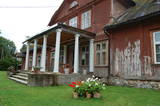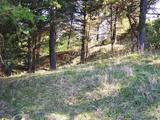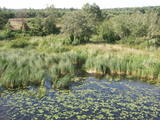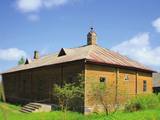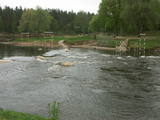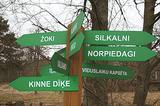| Nr | Name | Beschreibung |
|---|---|---|
|
Rekovas dzirnavas ir unikāla vieta pašā austrumu pierobežā. “Pirmajā stāvā bija miltu malšana un otrajā stāvā apstrādāja vilnu. Dzirnavas pastāvēja līdz 1980.gadam. Vēlāk ēka nevienam nepiederēja, lietus ietekmē iebruka jumts un faktiski viss bija sadrupis. 2016.gadā zemnieku saimniecības “Kotiņi” saimniekam Aldim Ločmelim radās iespēja iegādāt ēku un saliekot galvas kopā, radās ideja, ka ēkā varētu būt vietējās produkcijas veikaliņš.” Majestātiskā trīsstāvu pamatīgu laukakmeņu mūra ēka, kas atrodas pašā Balvi-Viļaka ceļa malā, ir sākusi dzīvot jaunu dzīvi, kur ikvienam ir iespēja nobaudīt vietējo Latgales produktu garšu dažādā izpildījumā. Dzirnavu saimniece - viena no īstajām latvju saimniecēm Vija Kuļša uzņem tūristu grupas, kurām piedāvā nobaudīt vietējo Latgales produktu garšu dažādā izpildījumā. Ēdienkarte sastāv no piedāvājuma vegāniem, veģetāriešiem un klasiskās ēdienkartes. Viena no galvenajām ēdienu sastāvdaļām ir zs “Kotiņi’’ ražotā produkcija. Ir iespēja pieteikt un darboties arī Meistarklasēs. Tiek piedāvāvāts ēdiens no linsēklām, linu eļļa, dažādi salāti, ko var gatavot ar linu eļļu. Linsēklas izmanto pašu ceptā maizītē, sāļajā baltmaizē ar linsēklām. Linsēklas Rekovas dzirnavu ēdienkartē ir tikai viena no izejvielām, bet tieši tās ir centrālais varonis jaunajā Ziemeļlatgales kultūrvēsturiskā tūrisma piedāvājumā “Linu ceļš Ziemeļlatgalē”. |
||
|
Mazs vietējais uzņēmums, kas ražo dažādus gardumus no ogām, augļiem un dārzeņiem. Interesenti tiek aicināti iegriezties ražotnē, lai iegādātos dažādus interesantus saldumus vai nobaudītu pašu gatavotu saldējumu. Iepriekš piesakoties, draugu grupām, ģimenēm u.c. kolektīviem ir iespējams piedalīties produktu degustācijās vai meistarklasēs. |
||
|
Piedāvā ļoti gardus Lietuviešu tradicionālos ēdienus. Var pieņemt līdz 300 personām. Ir āra terase un dzīvā mūzika. Pieņem bankas kartes, pieejama autostāvvieta. |
||
|
Das Museum befindet sich im Herrenhaus Uue-Varbla. Die Exposition zeigt das Leben vor Ort in der ersten Hälfte des vorigen Jahrhunderts und die Geschichte der Gemeinde Varbla. Im Museum ist ein Handarbeitszimmer. Im Getreidespeicher des Herrenhauses sind alte Werkzeuge und –maschinen ausgestellt. Sehenswert ist das aus dem Jahr 1797 stammende frühklassizistische Hauptgebäude aus Holz. Jedes Jahr im Juli findet ein Jahrmarkt für Handarbeit statt. |
||
|
Kirkas Hill in Micāni. In 1792, a small castle on the hill Priežukalns (Kirkas kalns) was rebuilt into
Lutheran Church. Nowadays, the hill still is called Kirkas kalns (in German „Kirche” means „church”).
Old people say – under the church there is a big cellar where the jewellery of church and the Mantefel
family is hidden; Manteifel family vault is there too.
|
||
|
Dieses Gebiet wird regelmäßig überflutet, wenn der Fluß Lielupe über seine Ufer tritt. Diese Auenwiesen sind wichtig für Vögel. Das Gebiet kann von der Straße Rīga-Liepāja und von der Straße nach Kalnciems aus, die daran entlang führen, betrachtet werden.
|
||
|
Zum ersten Mal ist der Name von Kandava in den schriftlichen Quellen im Jahr 1230 erwähnt worden. Im Jahr 1253 hat der Livländische Orden auf dem steilen Ufer des Urstromtales des Flusses Abava eine gemauerte Burg gebaut, an deren Fuß sich eine Siedlung herausgebildet hat. Im 17. Jh. wurde Kandava zu einem bedeutenden Handelszentrum. Die Stadt und ihre Einwohner haben schwer unter der Pest und den Ereignissen des Ersten Weltkriegs gelitten. Die Stadtrechte hat Kandava im Jahr 1917 erlangt. Während der Sowjetzeit wurde der Sportkomplex der Landwirtschaftlichen Fachschule von Jaunkandava zu einem bekannten Ort für Training. |
||
|
St. Alois Roman Catholic church of Ostrone (Ustroņu) was built
in 1935 in the time of dean B. Valpitrs CCM (Congregation Clericorum
Marianorum).
|
||
|
The rest complex is situated on the shore of the man-made water reservoir, and there are two saunas on the territory – the Big sauna and the Small sauna. In the building of the Big sauna it is possible to organise different events for as many as 40 people, and in summertime – till 60 people. In the Small sauna – up to 20 people. Apart from the saunas, there are offered 20 different picnic places with tables, places for grills and tents, volleyball playgrounds, boats and water-bicycles for rent. |
||
|
Tūrisma gide Ineta Jansone piedāvā ekskursijas grupām gar Kaņiera ezeru, iepazīstinot ar putniem, kuri mīt tā tuvumā. Kaņiera ezers ir vieta, kur migrācijas laikā apmetas daudzi tūkstoši ūdensputnu. Ezerā un tā apkārtnē sastopamas vairāk nekā 200 putnu sugu. Putnu vērotāju ērtībām vienā no Kaņiera ezera pussalām uzcelts putnu vērošanas tornis. Netālu no putnu vērošanas torņa izveidota koka laipa uz pontoniem, kura stiepjas cauri niedrāju audzei. Kaņiera ezers izceļas ar lielu daudzums zivju – tajā konstatētas gandrīz 20 zivju sugu. Izsens zvejnieku ciems - Lapmežciems atrodas skaistā vietā uz šauras zemes strēles starp Kaņiera ezeru un Rīgas jūras līci. Lapmežciemā izveidots zvejnieku muzejs, kuru var apmeklēt ekskursijas laikā, kā arī nobaudīt svaigi kūpinātas zivis. |
||
|
Das ist ein Territorium, das einzigartig in der lettischen und baltischen Ebene ist und das sich zwischen Valmiera und der Region von Gulbene erstreckt. Hier befindet sich das unbegradigte Gauja-Flusstal mit einem dichten System von alten Nebenflüssen. Die Wiesen auf den Flussbänken sind wichtig für die biologische Vielfalt. Hier gibt es Bestände an Eichen und Laubbäumen. Viele seltene und geschützte Vögel leben und nisten hier – der Wachtelkönig, der Specht usw. Das Territorium ist ausgezeichnet geeignet zur Vogelbeobachtung, für Naturstudien, ökologischen Tourismus und für verschiedene Arten des aktivem Tourismus.
|
||
|
Kretoņu (Kretuonas) ezera dienvidu krastā (ezeru gan neredz aizauguma dēļ) meklējams Kretoņu ciems. Šķiet, ka šī vieta ir „aizķērusies" pagātnē. Cauri ciemam iet viena iela, kurai abās pusēs izvietojušās 19. – 20. gs. mijā (dažas pat mazliet agrāk – 19. gs. vidū) celtās saimniecības. Te redzamas gan dzīvojamās, gan saimniecības ēkas, kuras rada etnogrāfiska brīvdabas muzeja sajūtu. Dažas no tām gan ir „padevušās" laika zobam. Lai vai kā, šis ir viens no neparastākajiem nacionālā parka etnogrāfiskajiem ciemiem, kuru pa „galveno ielu" vērts izstaigāt visā garumā. Šim, tāpat kā pārējiem etnogrāfiskajiem ciemiem ir piešķirts kultūras mantojuma objekta statuss. |
||
|
Košrags wird als das jüngste livische Dorf des Küstengebietes angesehen (im 17. Jahrhundert gegründet). Im Jahr 1826 gab es in Košrags 78 Einwohner. Im Jahr 1832 wurde in Žoki die erste Leseschule für livische Kinder in den Küstendörfern der Region Dundaga eröffnet, in der als Lehrer der erste fachlich ausgebildete Live Nick Polmanis arbeitete, der im östlichen Dialekt das Evangelium nach Matthäus übersetzt hat. In Košrags gab es eine Windmühle, eine Wassermühle und Bootswerften. Im Frühjahr legten hier Boote mit den Arbeitssuchenden von der Insel Saaremaa an. 1932 wurde der Hafen ausgebaut und 1938 eine Mole zur Sammlung von Seetang errichtet. In den 30er Jahren des vergangenen Jahrhunderts wurde Košrags regelmäßig von finnischen und estnischen Linguisten besucht, die hier die meisten Einheiten livischer Folklore gesammelt haben. Das Haus Norpiedagas wurde vom gesellschaftlichen Arbeiter livischer Abstammung, Didriķis Volganskis (1884–1968), erbaut. Dort wurde sein Sohn geboren, livischer Kulturarbeiter, Pfarrer (Finnland) Edgar Vaalgamaa (Volganskis, 1912–2003), der das Epos „Lāčplēsis“ (Bärenreißer) von A. Pumpurs ins Finnische übersetzt hat. Heute ist Sīkrags ein nationales Kulturdenkmal. |
||
|
Zuerst führt die Tour zu einem Hersteller, der Birkensäfte und aus denen auch Wein produziert. Hier können Sie dieses traditionelle und erfrischende Getränk auch verkosten. Danach führt die Tour zu einem Ziegenhof, wo Sie verschiedene Milchprodukte verkosten und Haustiere besichtigen können. Weiter fahren Sie nach Sigulda mit ihrer olympischen Bobbahn und drei mittelalterlichen Burgen – Sigulda, Turaida und Krimulda, die sich am Ufer des Flusses Gauja befinden. Durch diese Gegend weben sich auch viele malerische Spazierpfade. Weiter erkunden Sie das historische Dorf Ligatne, das sich um eine Papierfabrik gebildet hat, und besuchen lokale Handwerker, die in einer für diese Gegend typischen Höhle untergebracht sind. Cesis ist eine reizvolle Stadt mit dem sogenannten Neuen Schloss und mit eindrucksvollen Ruinen einer mittelalterlichen Burg. Besuchen Sie einen Hanfanbauer und verkosten Sie auf traditioneller Art vorbereiteten Hanf. In der Mühle von Koni können Sie zuschauen, wie mit altmodischen Geräten warme Bettwäsche handgemacht wird. Besuchen Sie eine Handwerkerwerkstatt in Staicele und versuchen Sie, mehr als 30 Nester in einer Störchenkolonie entlang einer Straße zu erblicken. In Mazsalaca befindet sich ein Naturpark mit Pfaden, die an den wunderschönen Ufern des Flusses Salaca führen. Dieser Fluss ist auch mit seinen Neunaugen bekannt. Weiter auf dieser Tour werden Sie die Möglichkeit haben, traditionelle Fischzäune zu sehen, mit denen die Neunaugen gefangen werden. In Saulkrasti können Sie einen Spaziergang auf dem Dünenpfad unternehmen und den Strand genießen. Weiter auf dieser Tour warten auf Sie Moore mit Moosbeeren, wo Sie diese gesunden Beeren in einer Form verkosten können, die von der entsprechenden Saison abhängt. Besuchen Sie das elegante Schloss von Birini mit seinem großen Park und dem ausgezeichneten Restaurant und kehren Sie nach Riga zurück. |
||
|
Dodieties ekskursijā, lai gūtu ieskatu lauku profesijā un dzīvesveidā, kā arī iegūtu jaunus iespaidus un labu atpūtu visai klasei. Ekskursijas laikā apciemojiet koka skulptūras Vienkoču parkā, kur iespējams iepazīties arī ar koka amatniecību un sameklēt dārgumu lādi. Vai arī apmeklējiet vienīgo vietu Baltijā, kur var iepazīties ar cilvēku dzīves apstākļiem pirms vairāk kā 1000 gadiem. Pēc tam apmeklējiet zemnieku saimniecību, kurā no cidonijām ražo sukādes, marmelādes, sīrupus un citus labumus, un pļavās ganās savvaļas zirgi. Ekskursijas noslēgumā dodieties uz Porcelāna fabriku, lai varētu padarboties apgleznošanas darbnīcā un iepazīties ar ražotni. |
||
|
Das Café befindet sich im Zentrum von Ludza. Hier kann man Gerichte aus einer vielfältigen Speisekarte und auch Tagesangebote wählen. Ein besonderes Angebot des Kochs sind Süßwasserische aus den Seen der Region Latgale. Lettische Küche: Speisen, bei deren Vorbereitung Hechte, Schleien, Karpfen und Zander verwendet werden. Während der Wintersonnenwende werden auf Bestellung Blutwürste, Bratwürste und Schweinerüssel vorbereitet. Das besondere Gericht: Fischkäse: kalte Vorspeise aus gemahlenem Fisch mit Zutaten. |
||
|
Das Restaurant Agnese lädt Gäste zu einer kulinarischen Weltreise ein. Lokale Naturprodukte und Produkte aus örtlichen Bauernhöfen werden mit Liebe zubereitet, wobei der Wert der lettischen Geschmacks hervorgehoben wird. Das Menü enthält auch weltweit anerkannte Rezepte. Im Restaurant sorgt der sprechende Papagei Charlie für eine gemütliche Atmosphäre. Zusammen mit einem leckeren Essen richtet sich bei jedem ein Festgefühl ein. |
||
|
Atrodas Celtnieku un Z. Mauriņas ielu krustojumā. Dievnams uzcelts 2000. gadā modernās arhitektūras formās (arhitekti Aija un Andris Kokini), kas simbolizē Noasa šķirstu vai zviedru laivas, kas atnesušas kristīgo ticību. |
||
|
This is a lovely place in Sigulda which has been painted (as the word "gleznotāji", which means "painters" suggests) and photographed for centuries. This is basically not a hill at all, it's just the place where the shore of the ancient Gauja River valley is split by the mighty Vējupīte ravine. You will have an excellent view of the Turaida Castle and the river valley. There are leisure facilities and a viewing platform there. You can ride to Paradīze hill via an electric car. |
||
|
Die Haupttätigkeit des bäuerlichen Betriebs ist Getreidezucht. Seit 2006 beschäftigt sich der Betrieb mit Milchviehzucht und seit 2008 – mit der Herstellung von Käse und Quark. Zur Zeit sind im Betrieb mehr als 200 Melkkühe, von deren Milch Rohmilch, Joghurt, Käse und Eis hergestellt werden. |
||





